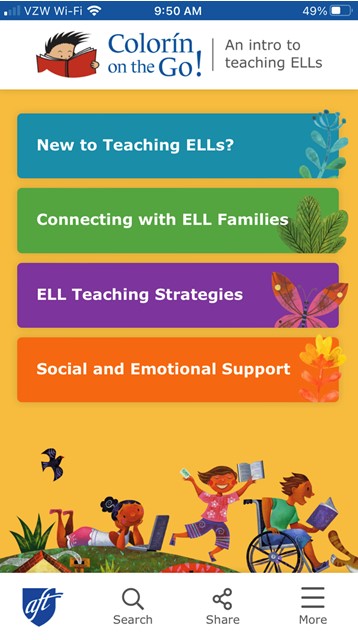Over the past several years, many school districts across the country have experienced the arrival of large groups of families who are resettling in their community simultaneously. Sometimes families are resettling due to a natural disaster, global events or conflicts, or changes in immigration policy. Currently, many asylum-seeking families are being resettled in communities (sometimes after being moved multiple times) whose schools have varying levels of experience in teaching English language learners (ELLs).
If your community is the new home for recently arrived families, there are a number of things schools can do to successfully welcome, support, and partner with newcomer students and families. Here are some ideas to help you get started, along with recommended resources that offer more in-depth information.
We have also included a few sample statewide resources from New York; your district or state may have similar resources available. For additional ideas related to resettlement after a natural disaster, see our related resource guide.
Note: Families from other countries may have a different cultural expectation related to school-family partnerships and also may be hesitant to share personal information about themselves. Proceed with care and sensitivity.
Communication
1. Determine which languages families speak.
The first step is to figure out which languages families speak in order to facilitate communication. In many schools, at the time of registration, families identify their preferred home language on a home language questionnaire, which may be available from your district or state.
It's critical not to make assumptions about languages spoken based on the family's country of origin or any other characteristics, particularly because multiple languages may be spoke in a single country. For example, families who have come from Afghanistan in recent years speak multiple languages and dialects, and many Indigenous families currently arriving from Latin America speak primarily Indigenous languages; in some cases, these families may speak Spanish as a second or third language at varying degrees of fluency. In a recent article on migrant families arriving in New York City from Ecuador, reporter Jordan Salama notes that many of the recent newcomers to the New York region are "Kichwa-speaking Indigenous people from Ecuador's rural central highlands." Indigenous families may be reluctant to share their Indigenous language or culture, though, and may do their best to get by in Spanish. (Learn more about partnering with Indigenous families in our related guide and videos below.)
In addition, Dr. Ayanna Cooper shares the story of Black Haitian students who were assumed to be African American and then questioned in their need for ESL services and their own background knowledge. This example underscores the importance of collecting accurate information from the outset without making any assumption about language or country of origin.
If you do not have interpreters available who speak families' languages that can help determine which languages they speak, talk to an administrator about getting additional support from resources such as those listed in the following recommendation.
Related resources:
- How School Leaders New to Working with ELLs Can Partner with Families: 10 Strategies for Success
- Partnering with Indigenous Families from Latin America
- Parents' Bill of Rights for New York State's English Language Learners
- Home Language Questionnaire (New York State)
2. Determine what your language access resources are.
Once you have identified the languages families speak, determine which resources are available from your school or district to support interpretation and translation. ELL educators and specialists may have this information available. Keep in mind that families are legally entitled to information in a language they understand from the school and that it is incumbent upon the school district to provide language access for all families enrolled in the district. If your district doesn't have appropriate options available, talk with administrators about getting support from a company providing telephone interpretation, state-level agencies, local community organizations and universities, or networks of interpreters specializing in your target languages (as in the case of Indigenous languages).
Related resources:
- Equity Through Language Access: Best Practices for Collaborating with Interpreters
- Partnering with Multilingual Families in Brockton, MA
3. Identify how families prefer to communicate.
Many families may be comfortable with certain ways of communication, such as texting, WhatsApp, or social media networks. If you meet families on the platforms they are already using, you are more likely to reach them effectively and establish two-way communication. TalkingPoints is another example of an app that allows educators to send translated text messages back and forth with families.
Related resources:
- Communicating with ELL Families: 10 Strategies for Schools
- How to Use Technology to Engage Multilingual Families
Legal Rights
4. Ensure that families and staff understand that all students have legal right to enroll in school.
All K-12 students in the United States have the legal right to enroll in a public school, regardless of their immigration status or that of their caretakers and family members. Make sure that all school staff, particularly the front office staff and registrars, understand that families have a legal right to enroll their children in school in the maximum age set by each state even if they have recently arrived in the country and even if they do not have documents like birth certificates. It's also important to ensure that families understand that right and responsibility. Many families may be living in shelters or in unstable housing; these students may have additional rights under the McKinney-Vento Homeless Assistance Act.
For example, in the report noted above about Ecuadorian migrant families, Jordan shares the story of a young woman who had recently arrived in New York and was told that school was too expensive for her to attend and that she would need to start selling candy to make ends meet. In some cases, families have received misinformation (unintentionally or intentionally) about their options relating to school in the U.S.
Note: Families having difficulty enrolling a child can contact the district office responsible for English learners or a community-based organization that serves immigrants for help.
Related resources:
- What Are the Legal Requirements Related to ELL Education?
- Immigrant Students' Legal Rights: An Overview
5. Ensure that families understand the legal rights they have related to special education.
If students have identified special needs or may need additional services, the school must ensure families have appropriate information in their home language about the services and any processes that are part of identification and support. Families may not know which services their students are entitled to or even know that schools provide special education services; experienced family liaisons -- working with interpreters, if necessary -- can help bring them into the process and make sure they have the information they need. In addition, keep in mind that students who qualify for English as a Second Language (ESL) services and special education are legally entitled to both sets of services, not one or the other.
Related resources:
- English Language Learners in Special Education: How to Partner With Your Students' Families
- Special Education and Your Child: FAQs for Multilingual Families (Tip sheet in 14 languages)
Social and Emotional Support
6. Look for ways to make families feel welcome.
There are many things schools can do to make newcomer families feel welcome. First and foremost, it's important to start the process of earning families' trust by showing them that school is a safe and welcoming place. Schools can do this by:
- connecting families with others who speak their language
- posting signs in their language (if it's a written language) or authentic photos and mementos from their home country
- providing a chance for them to meet teachers and ask questions
- demonstrating ways in which the school community welcomes different cultures
- inviting them to share their culture
- connecting families with resources or services they need
- featuring books in families' languages in the library or in displays
- recognizing important religious holidays as part of the school calendar
Related resources:
- Making Students and Families Feel Welcome
- How to Build Partnerships with Immigrant Families
- You Are Welcome Here: Support for Immigrant Students in Dearborn, Michigan
7. Identify sources to address possible trauma.
Many families and students may have experienced trauma before arriving in their new community. It's critical to develop culturally responsive, trauma-informed care as part of school-wide support. This may mean collaborating with members of the community to identify culturally appropriate practices and ensuring that families know about any resources at their disposal at the school or within the community – particularly those that are available to families regardless of immigration status. If there are topics or issues that seem to affect multiple students and families, it may be worth looking for broader school- or community-wide solutions.
Related resources:
- Using a Strengths-Based Approach with ELs: Supporting Students Living with Trauma, Violence and Chronic Stress
- Addressing Student Trauma, Anxiety, and Depression
- Dr. Karen Woodson: Partnering with Indigenous Families
Creating Systems-Wide Solutions
8. Create school records for students.
As new school records are created for students who enroll in your school, keep in mind that:
- Families may be arriving without any prior school records from their home country.
- When students move on to a new school, the more information they can take with them, the better.
While it may take some time to collect this information if many students are arriving at once, make it a priority to document the following in a format that would be easy for families to take to a new school if needed.
- Students' home languages
- Students' prior level of schooling and literacy
- Proficiency in English
Any identified special needs
Note: There are some useful recommendations on this topic related to children in migrant farmworker families, who are often transient and move between schools frequently.
Related resources:
- 10 Things You Need to Learn About Your English Language Learners
- Getting in Right: Reference Guides to Registering Students with Non-English Names (Institute of Educational Sciences and REL Northwest)
9. Consider bringing in ELL experts and community partners for support.
If your school is new to serving ELLs, consider bringing in an ELL expert who has experience working with schools and districts. Look for an expert with experience in the legal requirements related to ELL education, multilingual family engagement, providing guidance around staffing and professional development, programs of instruction, ELL certification requirements, and systems-wide recommendations that can make use of existing resources efficiently.
In addition, you may find great ideas by networking with other ELL educators in your district, region, state, or online. Many communities are addressing similar situations and can learn from each other.
You can also tap the educators in the school community, such as school nurses, social workers, school counselors, school psychologists for ideas and support, and you may also wish to partner with a community organization that serves the families who are arriving. They will have up-to-date information on the families' situations and what resources are available locally to help.
Related resources:
- What is an ELL educator?
- Hiring Your School's First ELL Teacher: 10 Tips for School Leaders
- ELL Facebook Group
Community partners
- Working with Community Organizations to Support ELL Students
- How a Community School Helps ELLs Succeed
- What Multilingual Health Services and Support Look Like in Brockton, MA
10. Start building the ELL capacity of all staff immediately.
Everyone can benefit from learning how to work effectively with ELLs, from tips to building relationships and creating a welcoming classroom to instructional ideas for scaffolding and making content accessible for newcomers. (These strategies can support other students as well!) In some cases, that training can be provided by current ELL staff to their colleagues; in other cases, bringing an external expert might be a better solution, especially if ELL staff are already managing a high caseload as they identify and place the new students in appropriate classrooms.
If more students are enrolling than your school currently has the capacity to teach, it's critical to ensure that teachers, administrators, and district leaders collaborate to compile and analyze all of the relevant data they need about the new students in order to make well-informed decisions related to staff, resource allocation, and funding streams.
Related resources:
- 10 Strategies for Building Relationships with ELLs
- 8 Tips for Welcoming Newcomer Students and Families to Your School
- How to Create a Welcoming Classroom Environment for ELLs
- 12 Ways Classroom Teachers Can Support ELLs
- Colorín on the Go: 100+ Strategies for Working with ELLs
- Supporting Newcomer Students: Resource Gallery
Closing Thoughts
While the path forward may not look clear at first, we have seen again and again that when the school community pulls together, it is possible to not only survive but to thrive. Doing so in a way that gives a voice to your new families not only builds your school's capacity to serve ELLs, but provides an opportunity to welcome your community's newest neighbors in the process!
Related Resources
To learn more about, see the following resources from the Migration Policy Institute:
- In the Twilight Zone: Record Number of U.S. Immigrants Are in Limbo Statuses
- What School Leaders Should Know About Immigrant Students and Families (published by the National Association of Secondary School Principals)
Books
- Powerful Practices for Supporting English Learners: Elevating Diverse Assets and Identities
- Teaching and Supporting English Learners: A Guide to Welcoming and Engaging Newcomers
Quick Tips from Colorín on the Go
 Colorín on the Go is a new web app from Colorín Colorado for teachers of English language learners (ELLs)! It offers more than 100 practical, shareable strategies featuring our most popular content across topics such as:
Colorín on the Go is a new web app from Colorín Colorado for teachers of English language learners (ELLs)! It offers more than 100 practical, shareable strategies featuring our most popular content across topics such as:
- ideas for new teachers of ELLs
- ELL instruction
- family engagement
- social and emotional support
You can get to Colorín on the Go by visiting go.colorincolorado.org from any device or using this QR code:









Add new comment